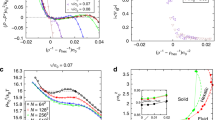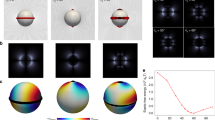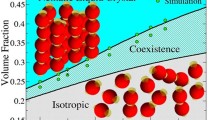Abstract
The phase behavior of a monolayer of dipolar hard spheres under an external field, which makes all dipoles of the monolayer orientate along its direction, is investigated. Using integral equation theory in the reference hypernetted chain (RHNC) approximation we calculate the correlation functions, which are used to obtain the response matrix of grand potential with respect to density fluctuations. The smallest eigenvalue of this response matrix determines the stability of the monolayer. When the smallest eigenvalue approaches zero, the monolayer becomes unstable and the corresponding eigenvector characterizes this instability. At dilute densities, with decreasing temperature the dipoles of the monolayer begin to form chains and simultaneously condensate. At medium and high densities, however, the dipoles of the monolayer have a stronger tendency to form dipolar chains with decreasing temperature and there is no condensation. The part of specific heat related to potential energy is investigated and found to increase sharply near the temperature of dipolar chain formation. This is in accordance with a sharp decrease in potential energy induced by the formation of a dipolar chain.
Similar content being viewed by others
References
Butter K, Bomans P H, Frederik P M, et al. Direct observation of dipolar chains in iron ferrofluids by cryogenic electron microscopy. Nat Mater, 2003, 2: 88–91
Klokkenburg M, Erné B H, Meeldijk J D, et al. In Situ imaging of fieldinduced hexagonal columns in magnetite ferrofluids. Phys Rev Lett, 2006, 97: 185702
Klokkenburg M, Dullens R P A, Kegel W K, et al. Quantitative realspace analysis of self-assembled structures of magnetic dipolar colloids. Phys Rev Lett, 2006, 96: 037203
Klokkenburg M, Erné B H, Wiedenmann A, et al. Dipolar structures in magnetite ferrofluids studied with small-angle neutron scattering with and without applied magnetic field. Phys Rev E, 2007, 75: 051408
Halsey T C, Toor W. Structure of electrorheological fluids. Phys Rev Lett, 1990, 65: 2820–2823
Lumsdon S O, Kaler E W, Velev O D. Two-dimensional crystallization of microspheres by a coplanar AC electric field. Langmuir, 2004, 20: 2108–2116
Weis J J, Tavares JM, Telo da Gama M M. Structural and conformational properties of a quasi-two-dimensional dipolar fluid. J Phys-Condes Matter, 2002, 14: 9171–9186
Weis J J. Simulation of quasi-two-dimensional dipolar systems. J Phys-Condes Matter, 2003, 15: S1471–S1495
Tavares J M, Weis J J, Telo da Gama M M. Quasi-two-dimensional dipolar fluid at low densities: Monte Carlo simulations and theory. Phys Rev E, 2002, 65: 061201
Tavares J M, Weis J J, Telo da Gama M M. Phase transition in two-dimensional dipolar fluids at low densities. Phys Rev E, 2006, 73: 041507
Duncan P D, Camp P J. Structure and dynamics in a monolayer of dipolar spheres. J Chem Phys, 2004, 121: 11322–11331
Duncan P D, Camp P J. Aggregation kinetics and the nature of phase separation in two-dimensional dipolar fluids. Phys Rev Lett, 2006, 97: 107202
Cerdá J J, Kantorovich S, Holm C. Aggregate formation in ferrofluid monolayers: Simulations and theory. J Phys-Condes Matter, 2008, 20: 204125
Osipov M A, Teixeira P I C, Telo da Gama M M. Structure of strongly dipolar fluids at low densities. Phys Rev E, 1996, 54: 2597–2609
Kantorovich S, Cerdá J J, Holm C. Microstructure analysis of monodisperse ferrofluid monolayers: Theory and simulation. Phys Chem Chem Phys, 2008, 10: 1883–1895
Ornstein L S, Zernike F. Acculental deviations of density and opalescence at the critical point of a simple substance. Proc Acad Sci (Amsterdam), 1914, 17: 793–806
Hansen J P, McDonald I R. Theory of Simple Liquids. 3rd ed. Amsterdam: Academic Press, 2006
Fries P H, Patey G N. The solution of the hypernetted-chain approximation for fluids of nonspherical particles. A general method with application to dipolar hard spheres. J Chem Phys, 1985, 82: 429–440
Kinoshita M, Harada M. Numerical solution of the HNC equation for fluids of non-spherical particles. An efficient method with application to dipolar hard spheres. Mol Phys, 1991, 74: 443–464
Klapp S H L, Forstmann F. Phase transitions in dipolar fluids: An integral equation study. J Chem Phys, 1997, 106: 9743–9761
Klapp S H L, Forstmann F. Phase behavior of aligned dipolar hard spheres: Integral equations and density functional results. Phys Rev E, 1999, 60: 3183–3198
Range G M, Klapp S H L. Pair formation and global ordering of strongly interacting ferrocolloid mixtures: An integral equation study. J Chem Phys, 2006, 124: 114707
Hoffmann N, Likos C N, Löwen H. Correlations of two-dimensional super-paramagnetic colloids in tilted external magnetic fields. Mol Phys, 2007, 105: 1849–1860
Luo L, Klapp S H L. Fluctuations in a ferrofluid monolayer: An integral equation study. J Chem Phys, 2009, 131: 034709
van Leeuwen J M J, Groeneveld J, de Boer J. New method for the calculation of the pair correlation function. I. Physica, 1959, 25: 792–808; Meeron E. Nodal expansions. 3. Exact integral equations for particle correlation functions. J Math Phys, 1960, 1: 192–201; Morita T, Hiroike K. Theory of classical fluids: Hyper-Netted chain approximation. III. A new integral equation for the pair distribution function. Prog Theor Phys, 1960, 23: 829–845
Guo X, Riebel U. Theoretical direct correlation function for twodimensional fluids of monodisperse hard spheres. J Chem Phys, 2006, 125: 144504
Lado F. Numerical Fourier transforms in one, two, and three dimensions for liquid state calculations. J Comput Phys, 1971, 8: 417–433
Chen X S, Kasch M, Forstmann F. Demixing phase transition in amixture of hard-sphere dipoles and neutral hard spheres. Phys Rev Lett, 1991, 67: 2674–2677
Chen X S, Forstmann F. The phase instability of molecular fluid mixtures: Dipolar and neutral hard spheres. Mol Phys, 1992, 76: 1203–1211
Author information
Authors and Affiliations
Corresponding author
Rights and permissions
About this article
Cite this article
Luo, L., Chen, X. Chain formation in a monolayer of dipolar hard spheres under an external field. Sci. China Phys. Mech. Astron. 54, 1555 (2011). https://doi.org/10.1007/s11433-011-4428-4
Received:
Accepted:
Published:
DOI: https://doi.org/10.1007/s11433-011-4428-4




